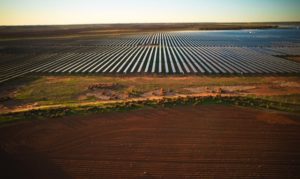The combination of growing rooftop solar installations, mild temperatures and sunny weather has pushed South Australia’s grid demand to yet another record low, this time shaving around 6 per cent off the previous low set just six weeks ago.
The new low was set just before 1.30pm in South Australia (just before 2pm on National Electricity Market time) when the minimum grid demand hit 554MW.
This shaved some 33MW off the previous low of 587MW set on September 17,which itself was nearly 200MW or 25 per cent the previous record low demand of 786MW set just a week earlier.

For six hours, according to the APVI solar map, rooftop solar PV provided more than 30 per cent of the state’s demand. For nearly three hours, rooftop solar provided more than 40 per cent of the state’s demand.
As we explore in this article here, rooftop solar provided 9.2 per cent of the state’s local generation in 2016/17 and would likely be more than 10 per cent if larger rooftop solar installations were included.
Within a decade, that share is expected to double to more than 20 per cent, at which times on days like this Sunday, minimum demand may actually fall to zero because of the amount of solar being generated.
The Australian Energy Market Operator, which includes these forecasts in a new report into the South Australia grid, suggests that by that time it will be necessary to store some of that excess solar for use later in the day.
The same situation may occur in West Australia, too, because of the amount of rooftop solar being installed in a small grid. The uptake of rooftop solar is accelerating because of high grid prices and the falling cost of solar technology, and grid demand fell in W.A. to an 8-year low last week.
“At these times, South Australia could store or export its excess generation to the rest of the NEM via the interconnectors, provided they are in service,” AEMO notes in its report.
“This, in turn, will provide market participants with greater opportunity to manage their energy use.”
AEMO noted, as it has previously, that South Australia is the first region in the NEM in which high rooftop PV penetration has caused minimum demand to shift from overnight to near midday – a transition that occurred five years ago.
Many argue this is a good reason to shift the “controlled load” of electric hot water systems from the night-time to the mid-day hours, particularly since the closure of the coal fired generators which could not be switched off at night and needed something to power during the night time.
However, problems with the nature of the metering, and the potential expense of the shift, are barriers to the migration of hot water systems to the day-time hours.











